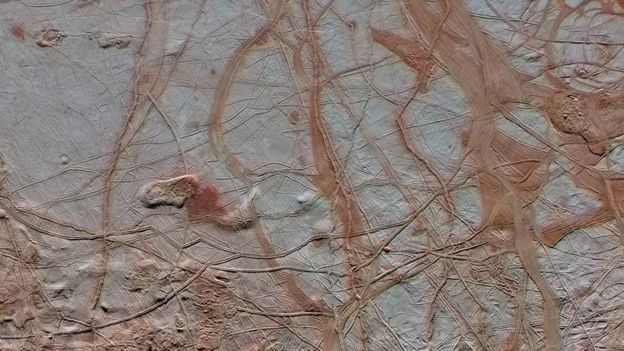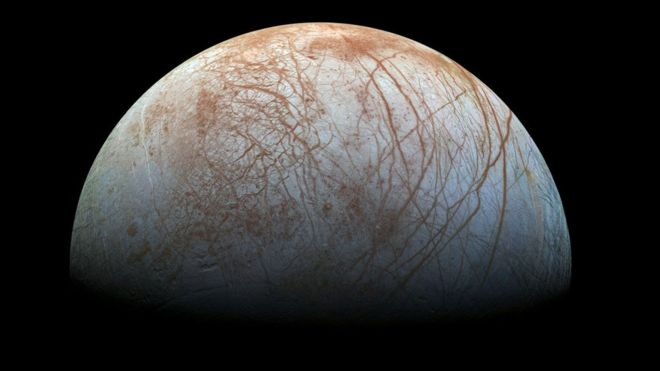木星の衛星「エウロパ」から水が噴出
Europa moon 'spewing water jets'
Further evidence has been obtained to show that Jupiter's icy moon Europa throws jets of water out into space.
木星の凍った衛星「エウロパ」が、ジェット水を宇宙へ向けて放出していることを表す、いくつかの証拠は得られていました。
Scientists first reported the behaviour in 2013 using the Hubble telescope, but have now made a follow-up sighting.
科学者は、2013年にハッブル宇宙望遠鏡を使って、この振る舞いを最初に報告しました。 そして、いま、それを裏付ける見方を得たのです。
It is significant because Europa, with its huge subsurface ocean of liquid water, is one of the most likely places to find microbial life beyond Earth.
これは重大なことです。エウロパは、その巨大な表面の液体の水の海で、地球以外で、もっとも微生物が見つかりやすい場所だからです。
Flying through the jets with an instrumented spacecraft would be an effective way to test the possibility.
このジェットの中を配備された宇宙船で飛行することが、その可能性を試験する効果的な方法となるでしょう。
One could even attempt to capture a sample of ejected material and bring it back to Earth for more detailed biological analysis.
さらに生物学的に詳細な分析を行うために、ある人は、取り出された物質のサンプルをとらえて、地球へ持ち帰る試みも可能だといいます。
The alternative - of trying to land on the moon and drill through perhaps tens of kilometres of ice to examine the ocean's water - would be immensely challenging.
その替わりの方法 ― 海水を確認するために、この衛星へ着陸して、もしかすると10キロメートルもの氷を掘削する試みること ― は、非常に困難な挑戦となるでしょう。
- immensely - 非常に
Hubble made its latest identification by studying Europa as it passed in front of Jupiter.
ハッブルはその最新の識別を、エウロパが木星の正面を通過することを学習して行いました。
The telescope looked in ultraviolet wavelengths to see if the giant planet's light was in any way being absorbed by material emanating from the moon's surface.
この望遠鏡は、紫外線の波長によって、 巨大な惑星の光が、この衛星の表面から発散する物質によって、何らかの方法で遮られるかどうかを見ることで 観測を行いました。
- emanating - 発散
Ten times Hubble looked and on three of those occasions it spied what appeared to be "dark fingers" extending from the edge of Europa.
ハッブルは10回のうち、これらの3回の機会を観測した。 エウロパの端から「暗い複数の指」が伸びるように現れたものを見張っていた。
William Sparks, the lead astronomer on the study, said he could think of no natural phenomenon other than water plumes that might produce such protuberances.
この研究の天文学者のリーダーであるウィリアム・スパークスは、このような突起を作り出す自然現象は、水の上昇流以外にはないと考えられると言いました。
- plumes - 煙や雲の柱、マントル対流、上昇流
- protuberances - 突起
"We're not aware of any instrumental artefacts that could cause these features; they are statistically significant. But we remain cautious because we are working at difficult wavelengths for Hubble," he told reporters.
「私たちは、これらの現象を引き起こす、いかなる人工的なものも、承知していない。 それらは、統計的に重要です。 しかし、私たちは、ハッブルにとって難しい波長において取り組んでいるため、用心深くあり続けます。」 このように、彼は記者に語りました。
- artefacts - 人工の産物
- cautious - 用心深い
"We do not claim to have proven the existence of plumes, but rather to have contributed evidence that such activity may be present." Nonetheless, the location for the putative jets looks very similar to the region where Hubble earlier this decade detected an excess of oxygen and hydrogen - the component parts of water.
That certainly made for an intriguing case, said Hubble's senior project scientist, Jennifer Wiseman.
"The [earlier work] used spectroscopy, so they really could discern evidence of dissociated water molecules," she commented.
"The Sparks team discovered evidence of plume activity through imaging - visually. So these are different approaches but they complement one another, and they appear to be independent evidence of plume activity on Europa."
The suggestion is that the jets reach several hundred kilometres in height before then falling back on to Europa. The calculation based on the 2013-reported work estimated a volume of water equivalent to an Olympic swimming pool could be being spewed into space about every eight minutes.
What is clear though is that any activity is sporadic, and scientists will need to understand why that should be so.

Water jets have already been seen up close at Enceladus, an icy moon of Saturn. These emanate from a series of fissures at its south pole.
The Cassini spacecraft, in orbit currently at Saturn, has even dived through the emissions to "taste" some of their chemistry. But the probe's instrumentation is not designed to detect the presence or activity of microbes. That would require a mission dedicated to the task.
The US space agency (Nasa) has just sent a satellite to Jupiter called Juno, but again this has no life-detection equipment onboard and, in any case, is not going anywhere near Europa in the course of its work.
Both Nasa and the European space agency do however have future missions in the planning stage that will visit Europa to make repeated flybys, and the determination that the moon has water jets will surely factor into the organisations' thinking.
Curt Niebur, who works on the American concept, said the spacecraft would have instruments that could "aggressively investigate" any plumes, but he also stressed that obtaining convincing proof that microbes lived at Europa was far from easy.
"The Europa flyby mission which will launch in the 2020s is not a life-finding mission," he explained. "That mission is focused on assessing the habitability of Europa.
"And we do it in this way for a very simple reason: we know how to measure habitability; we have a lot of experience at doing that; we have a lot of instruments that are very robust and good at doing that. When it comes to finding life, we don't have as much experience. And we actually have an ongoing and vigorous debate in the scientific community as to the best way of going about detecting life on a mission such as this."
What was not in doubt, said Paul Hertz, the director of the astrophysics at Nasa, was Europa's profile as a key target in the search for extra-terrestrial life: "On Earth, life is found wherever there is energy, water and nutrients. So we have a special interest in any place that might posses those characteristics. And Europa might be such a place."
Follow Jonathan on Twitter.
元記事はこちら。

![エウロパ [DVD]](http://ecx.images-amazon.com/images/I/61C6clExZRL._SL160_.jpg)
